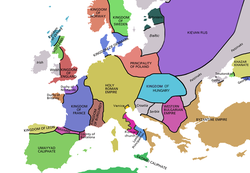უნგრეთის სამთავრო
უნგრეთის სამთავრო[1][2][3][4][5] (უნგრ. Magyar Nagyfejedelemség) — ყველაზე ადრეული დოკუმენტირებული უნგრული პოლიტიკური ერთეული შუა დუნაის დაბლობის ტერიტორიაზე, რომელიც IX საუკუნეში უნგრელების მიერ შუა დუნაის დაბლობის დაპყრობის შედეგად 895 ან 896 წელს წარმოიქმნა.[6][7][8][9]
| უნგრეთის სამთავრო უნგრ. Magyar Nagyfejedelemség | |||||||||
| |||||||||
|---|---|---|---|---|---|---|---|---|---|
| |||||||||
 უნგრეთის სამთავრო 998 წელს | |||||||||
| დედაქალაქი | ესტერგომი ან სეკეშფეხერვარი | ||||||||
| მმართველობის ფორმა | კონფედერაციული სამთავრო | ||||||||
| ნადფეიედელემი | |||||||||
| - 895 – 907 | არპადი | ||||||||
| - 907–947 | ჟოლტი | ||||||||
| - 947-955 | ფაისი | ||||||||
| - 955-972 | ტაკშონი | ||||||||
| - 972-997 | გეზა | ||||||||
| - 997-1000 | იშტვან I | ||||||||
| ისტორია | |||||||||
| - დაარსება | IX საუკუნე | ||||||||
| - დასასრული | 1000 | ||||||||
მადიარების ტომების გაერთიანებულმა ბელადმა არპადმა IX საუკუნის ბოლოს შექმნა უნგრეთის სამთავრო.[8][10][11][12][2] ისინი მოვიდნენ ეტელკოზიდან, რომელიც მდებარეობდა კარპატების აღმოსავლეთით.[13]
იმ პერიოდის ბიზანტიურ წყაროებში მას მოიხსენიებდნენ აგრეთვე როგორც: დასავლეთ თურქია.[14][15] დაახლოებით 960 წლის ხაზარების ებრაულ ენოვან წყაროებში ტერიტორია მოიხსენიება როგორც უნგრელების მიწა.[16]
უნგრული ისტორიოგრაფია 896-1000 პერიოდს მოიხსენიებს სამთავროს საუკუნედ. სამთავრო 1000 წელს ჩაანაცვლა ქრისტიანულმა უნგრეთის სამეფო, რომელსაც სათავეში ედგა მეფე - იშტვან I.[17][18][19]
იხილეთ აგრეთვე
რედაქტირებასქოლიო
რედაქტირება- ↑ S. Wise Bauer, The history of the medieval world: from the conversion of Constantine to the First Crusade, W. W. Norton & Company, 2010, p. 586
- ↑ 2.0 2.1 George H. Hodos, The East-Central European region: an historical outline, Greenwood Publishing Group, 1999, p. 19
- ↑ Ferenc Glatz, Magyar Történelmi Társulat, Études historiques hongroises 1990: Environment and society in Hungary, Institute of History of the Hungarian Academy of Sciences, 1990, p. 10
- ↑ Acta historica, Volumes 105-110, József Attila Tudom. Bölcs. Kar, 1998, p. 28
- ↑ Oksana Buranbaeva, Vanja Mladineo, Culture and Customs of Hungary, ABC-CLIO, 2011, p. 19
- ↑ The encyclopedia Americana, Volume 14, Grolier Incorporated, 2002, p. 581
- ↑ Encyclopedia Americana, Volume 1, Scholastic Library Pub., 2006, p. 581
- ↑ 8.0 8.1 Louis Komzsik, Cycles of Time: From Infinity to Eternity, Trafford Publishing, 2011 p. 54
- ↑ Zahava Szász Stessel, Wine and thorns in Tokay Valley: Jewish life in Hungary : the history of Abaújszántó, Fairleigh Dickinson Univ Press, 1995, p. 47
- ↑ Peter Linehan,Janet Laughland Nelson. 2001. p. 79
- ↑ Anatoly Michailovich Khazanov,André Wink. 2001. p. 103
- ↑ Lendvai. 2003. p. 15
- ↑ Paul Lendvai, The Hungarians: a thousand years of victory in defeat, C. Hurst & Co. Publishers, 2003, p. 15-29, p. 533
- ↑ Peter B. Golden, Nomads and their neighbours in the Russian steppe: Turks, Khazars and Qipchaqs, Ashgate/Variorum, 2003. "Tenth-century Byzantine sources, speaking in cultural more than ethnic terms, acknowledged a wide zone of diffusion by referring to the Khazar lands as 'Eastern Tourkia' and Hungary as 'Western Tourkia.'" Carter Vaughn Findley, The Turks in the World History დაარქივებული 2016-02-05 საიტზე Wayback Machine. , Oxford University Press, 2005, p. 51, citing Peter B. Golden, 'Imperial Ideology and the Sources of Political Unity Amongst the Pre-Činggisid Nomads of Western Eurasia,' Archivum Eurasiae Medii Aevi 2 (1982), 37–76.
- ↑ Carter V. Findley, The Turks in world history, Oxford University Press, 2005, p. 51
- ↑ Raphael Patai, The Jews of Hungary: History, Culture, Psychology, Wayne State University Press, 1996, p. 29, ISBN 978-0814325612
- ↑ University of British Columbia. Committee for Medieval Studies, Studies in medieval and renaissance history, Committee for Medieval Studies, University of British Columbia, 1980, p. 159
- ↑ Peter F. Sugar,Péter Hanák [1] A History of Hungary, Indiana University Press, 1994, pp 12-17
- ↑ Pál Engel, Tamás Pálosfalvi, Andrew Ayton, The Realm of St. Stephen: A History of Medieval Hungary, 895-1526, .B.Tauris, 2005, p. 27

